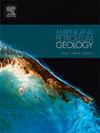Exploring the evolution of antithetic normal fault architecture and its constraints on fault transmissibility: Evidence from sand–box simulation experiments
IF 3.6
2区 地球科学
Q1 GEOSCIENCES, MULTIDISCIPLINARY
引用次数: 0
Abstract
Antithetic normal faults play an important role in the tectono–stratigraphic evolution of extensional basins. These faults also control the regional accumulation and distribution of oil and gas, and form an important channel for oil and gas longitudinal migration. However, the evolution of such faults architecture and their hydrocarbon conduction and accumulation are not well constrained. This work examines the evolution of such fault zones and their oil conduction process by employing sand–box simulations based on the actual antithetic normal fault with coring in the Dongying depression. The study reveals that the antithetic normal fault in semi–consolidated strata evolves from initial small faults based on drag folding, the drag in their damage zones effect also makes some fault properties reverse, and the intermittent dilation zone indirectly improves the physical properties of the secondary fault. The fault displacement controls the longitudinal oil–bearing layers and their saturation in the whole fault zone. The number of oil–bearing layers and their oil saturation decrease with decreasing of the total fault displacement. The longitudinal conduction of the fault is controlled by the displacement of the secondary faults in the damage zone. In semi–consolidated strata, the fault further evolves from drag folds, forming extensional fault–related folds overlapped with secondary faults in the damage zone. The secondary faults control the longitudinal conduction of oil and the drag folds become favorable reservoir space. Thus, the mudstone sealing of the main fault and conduction of the entire fault zone are two co–existing but not contradictory geological processes. The results of this study provide a new way to evaluate the transmissibility of the growth fault in extensional basins.
探索反常断层结构的演变及其对断层传递性的制约:来自沙箱模拟实验的证据
逆断层在伸展盆地的构造地层演化过程中发挥着重要作用。这些断层还控制着油气的区域积聚和分布,是油气纵向迁移的重要通道。然而,这类断层的构造演化及其油气的传导和积聚并没有得到很好的约束。本研究以东营凹陷实际的反常断层为基础,通过取芯进行沙箱模拟,研究了此类断层带的演化及其导油过程。研究发现,半固结地层中的逆正断层是由最初的小断层在拖动折叠的基础上演化而成的,其破坏带的拖动效应也使部分断层性质发生逆转,间歇性扩张带间接改善了次级断层的物理性质。断层位移控制着整个断层带的纵向含油层及其饱和度。含油层数及其含油饱和度随断层总位移的减小而减小。断层的纵向传导受破坏区次级断层位移的控制。在半固结地层中,断层由拖动褶皱进一步演化,形成延伸断层相关褶皱,并与破坏带中的次级断层重叠。次生断层控制着石油的纵向传导,而拖动褶皱则成为有利的储层空间。因此,主断层的泥岩封堵和整个断层带的导油是两个并存但并不矛盾的地质过程。该研究结果为评价伸展盆地中生长断层的传导性提供了一种新的方法。
本文章由计算机程序翻译,如有差异,请以英文原文为准。
求助全文
约1分钟内获得全文
求助全文
来源期刊

Marine and Petroleum Geology
地学-地球科学综合
CiteScore
8.80
自引率
14.30%
发文量
475
审稿时长
63 days
期刊介绍:
Marine and Petroleum Geology is the pre-eminent international forum for the exchange of multidisciplinary concepts, interpretations and techniques for all concerned with marine and petroleum geology in industry, government and academia. Rapid bimonthly publication allows early communications of papers or short communications to the geoscience community.
Marine and Petroleum Geology is essential reading for geologists, geophysicists and explorationists in industry, government and academia working in the following areas: marine geology; basin analysis and evaluation; organic geochemistry; reserve/resource estimation; seismic stratigraphy; thermal models of basic evolution; sedimentary geology; continental margins; geophysical interpretation; structural geology/tectonics; formation evaluation techniques; well logging.
 求助内容:
求助内容: 应助结果提醒方式:
应助结果提醒方式:


